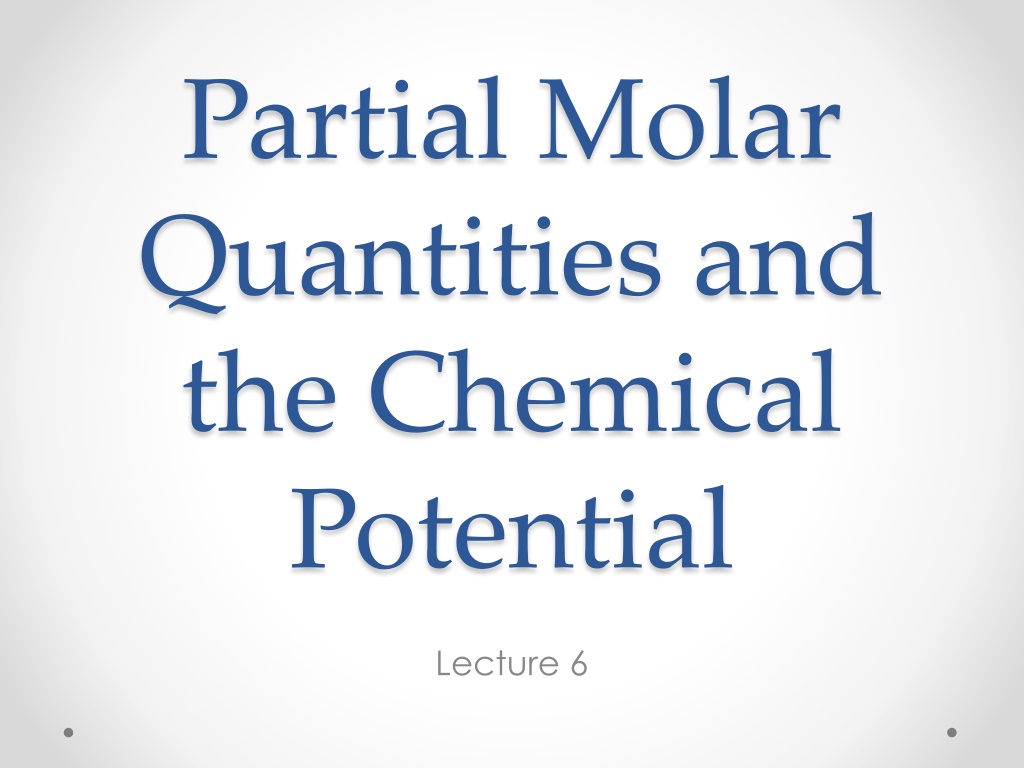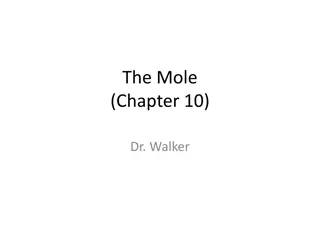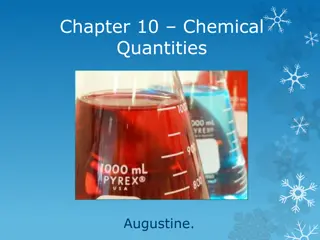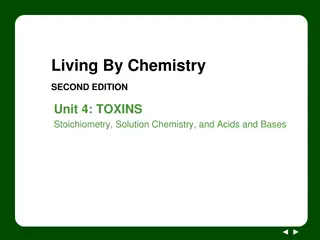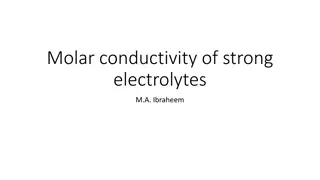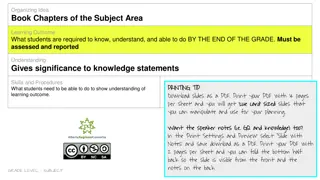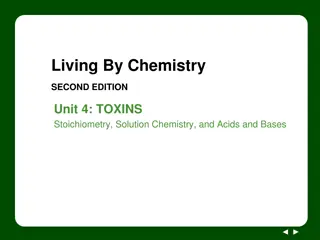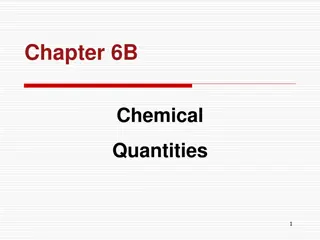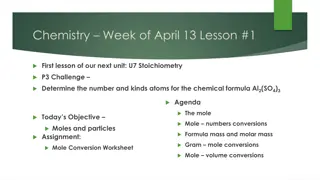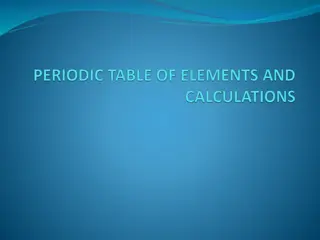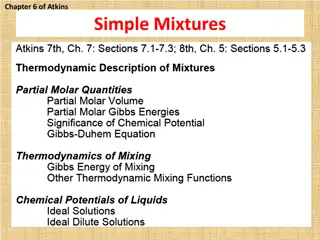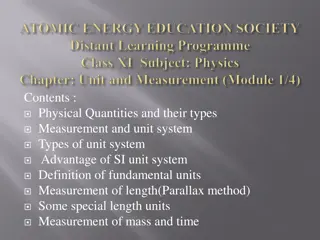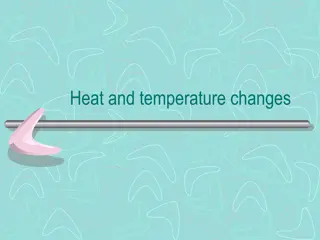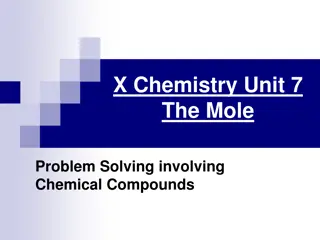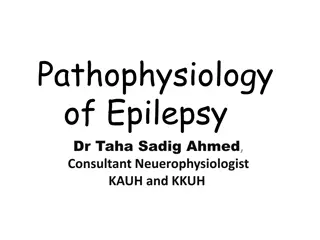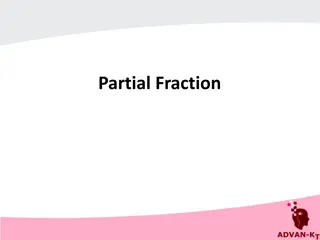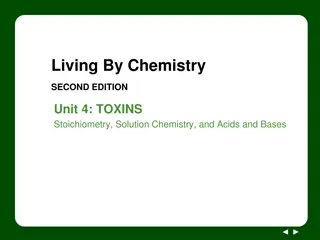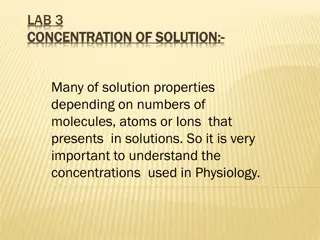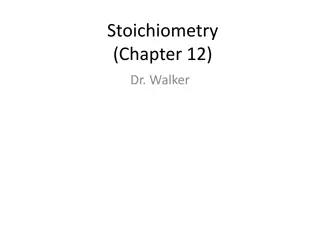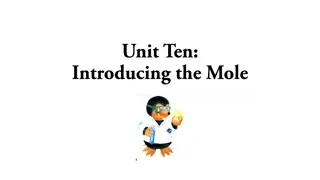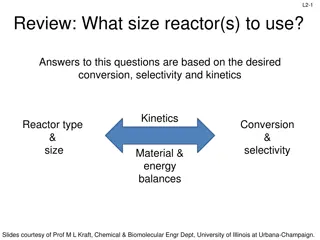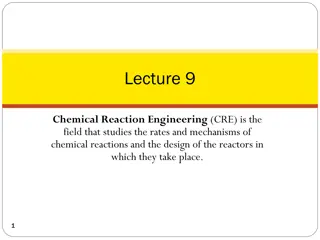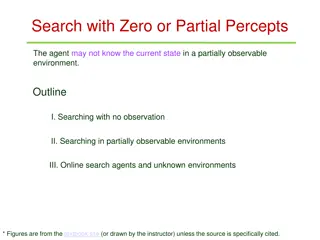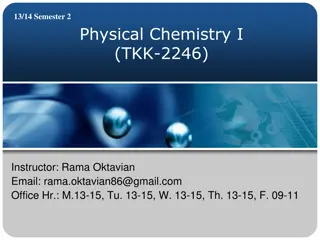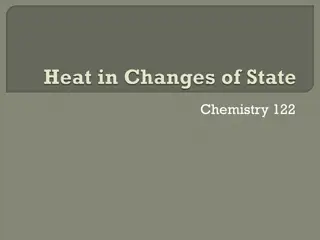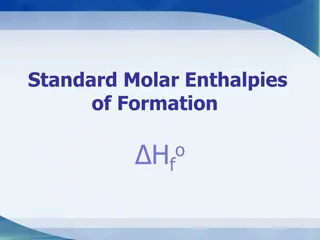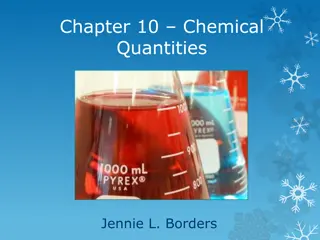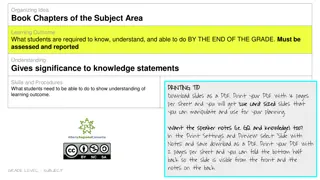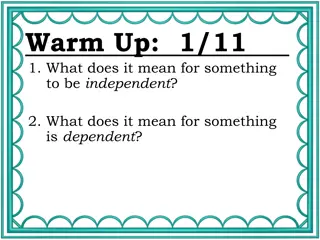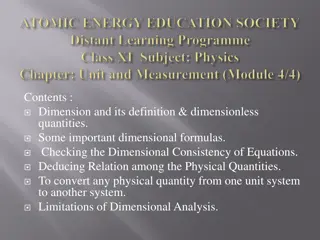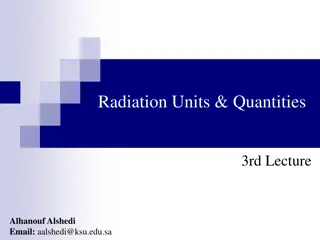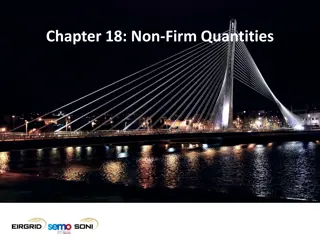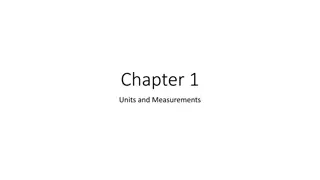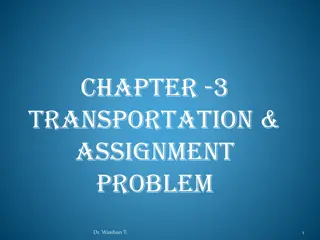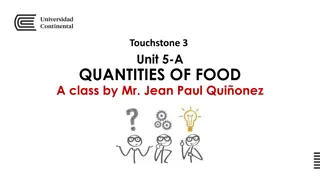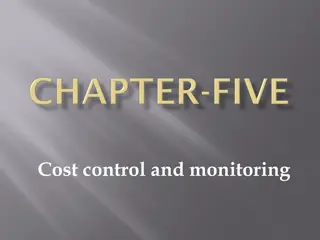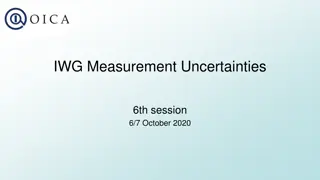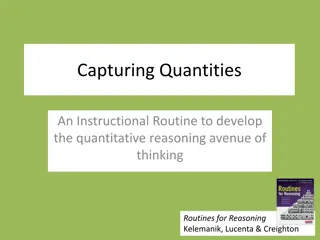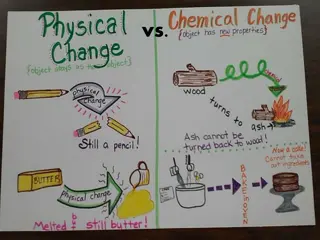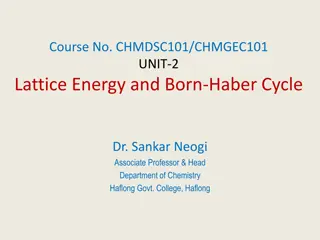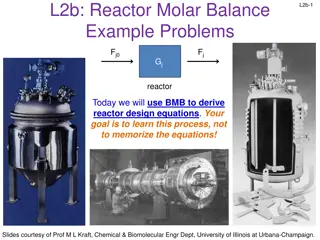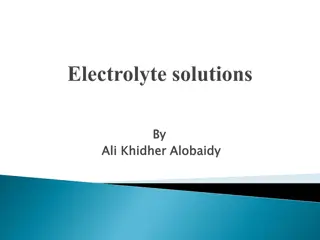Understanding Partial Molar Quantities and Chemical Potential
Exploring partial molar quantities and chemical potential in thermodynamics helps us understand how system variables change with composition alterations. Through concepts like partial molar volumes and Gibbs free energy, we can delve into the intricate dynamics of thermodynamic systems and their behavior. Chemical potential sheds light on how Gibbs free energy varies with the number of moles of a component, holding other factors constant, offering valuable insights into system energetics.
Download Presentation

Please find below an Image/Link to download the presentation.
The content on the website is provided AS IS for your information and personal use only. It may not be sold, licensed, or shared on other websites without obtaining consent from the author. Download presentation by click this link. If you encounter any issues during the download, it is possible that the publisher has removed the file from their server.
E N D
Presentation Transcript
Partial Molar Quantities and the Chemical Potential Lecture 6
Partial Molar Quantities Now that we have introduced the mole fraction, X, and variable composition, we want to know how the variables of our system, e.g., V, S, change as we change composition. o These are partial molar quantities, usually indicated by the lower case letter. For example: ni V vi= T,P,j i i nivi=V o Such that This is the partial molar volume of component i. For example, the partial molar volume of O2dissolved in seawater. o This tell us how the volume of water changes for an addition of dissolved O2holding T, P, and the amounts of everything else constant.
Partial Molar Volumes of Ethanol and Water If you add a shot (3 oz) of rum to 12 oz of Coca Cola, what will be the volume of your rum n coke ? Less than 15 oz! Blame chemistry, not the bartender.
Other Partial Molar Quantities We can also define partial molar quantities of other thermodynamic variables, such as entropy, and enthalpy. One partial molar quantity is particularly useful, that of the Gibbs Free Energy.
Chemical Potential The chemical potential is defined as partial molar Gibbs Free Energy: G ni i= such that i=1 =G ni i T,P,ni,i j or, dividing each side by the total number of moles: o i=1 =G Xi i The chemical potential tells us how the Gibbs Free Energy will vary with the number of moles, ni, of component i holding temperature, pressure, and the number of moles of all other components constant. For a pure substance, the chemical potential is equal to its molar Gibbs Free Energy (also the molar Helmholtz Free Energy): i o=Gi
Gibbs Free Energy Again In Chapter 2, we found that the Gibbs Free Energy change of a system (and we are only interested in changes, not absolute amounts) was given by: dG = VdP SdT o (you need to memorize this equation think about units and how free energy is minimized when entropy is maximized.) We also said that for a reaction at constant temperature and pressure: Gr= Hr T Sr These equation hold for a system of fixed composition. Where composition can vary, we need to modify them to account for that variance.
The total Gibbs free energy of a system will depend upon composition as well as on temperature and pressure. The Gibbs free energy change of a phase of variable composition is fully expressed as: dG =VdP-SdT + i idni Now consider exchange of component i between two phases, and holding all else constant; then: adni a+ i bdni b dG = i For a closed system: a= -dni b dni At equilibrium (dG = 0), then: a= i b i In a system at equilibrium, the chemical potential of every component in a phase is equal to the chemical potential of that component in every other phase in which that component is present.
Gibbs-Duhem Equation The Free Energy of a system (or phase) is the sum of chemical potentials of its components: i G = ni i Differentiating: dG = nid i+ idni Equating with the earlier equation: nid i+ =VdP+SdT + idni idni We can rearrange this as the Gibbs-Duhem Equation: VdP+SdT - = 0 nid i
Interpreting Gibbs- Duhem VdP+SdT - = 0 nid i In a closed system at equilibrium, net changes in chemical potential will occur only as a result of changes in temperature or pressure. At constant temperature and pressure, there can be no net change in chemical potential at equilibrium: nid i= 0 This equation further tells us that the chemical potentials do not vary independently, but change in a related way.
Final point about chemical potential: In spontaneous processes, components or species are distributed between phases so as to minimize the chemical potential of all components.
Chemical Potential in Ideal Solutions G P =V T i P = vi In terms of partial molar quantities T i P =RT For an ideal gas: P T,ideal o= RT lnP P- i i Integrating from P to P: Where P is the pressure of pure substance in its standard state and is the chemical potential of i in that state. In that case, P/P = Xi and: P i,ideal= i o+RT lnXi
i,ideal= i o+RT lnXi This equation tells us that in an ideal solution: o the chemical potential of component i is always less than that of pure i, since X is by definition less than 1 and hence ln X is negative. o the chemical potential of component i increases linearly with the log of its concentration in the solution.
Volume and enthalpy changes of solutions Water alcohol is an example of a non-ideal solution. The volume is expressed as: i V = XiVi+ Vmixing Vmixingterm may be negative, as in rum n coke. Similarly, mix nitric acid and water and the solution gets hot that thermal energy is the enthapy of mixing. Enthalpy of solutions is expressed as: H = XiHi+ Hmixing o The H term is positive in the nitric acid case. For ideal solutions, however, Vmixing= Hmixing = 0
Entropy changes of solution What about entropy and free energy changes of ideal solutions? Even in ideal solutions, there is an entropy change (increase) because we have increased the randomness of the system. The entropy change of ideal solution is: i Sidealmixing= -R XilnXi o Note similarity to configurational entropy. o Note negative sign. How will entropy change? The total (molar) entropy of an ideal solution is then: i i i S = XiSi+ Sidealmixing = - R XilnXi XiSi
What does this tell us about how Gibbs Free Energy will change in a ideal solution? Gr= Hr T Sr
Free Energy Change of Solution Gmixing= Hmixing - T Smixing For an ideal solution, Hmixing = 0 And Gidealmixing = RT i XilnXi Because the log term is always negative, ideal solutions have lower free energy than a mixture of their pure constituents and G decreases with increasing T. This is why things are usually more soluble at higher T. Total Free Energy of an ideal solution is: i Gidealsolution= XiGi+ Gidealmixing
Total Free Energy of an Ideal Solution i Recalling that and G = Xi i We can substitute i,ideal= i o+ RT lnXi Into the above and obtain: Gideal = + RT o XilnXi Xi i
Total Free Energy of an Ideal Solution Gideal = +RT o XilnXi Xi i The Free Energy of a solution is simply the sum of the chemical potentials of the components times their mole fractions. (Note that I have shortened the subscript from ideal solution to simply ideal). Since i o=Gi This equation is entirely equivalent to the one we previously derived: i Gideal= XiGi+ Gidealmixing The first term on the right is the sum of the contribution of the chemical potentials of the pure components. The second term on the right is the decrease in free energy that comes from the increase in entropy. o The second term on the right will always be negative because the mole fractions are by definition less than 1, hence their logs are always negative. Equivalently: Gideal = Xi i
Lets now see what happens to Free Energy when we dissolve component 2 in component 1 to create an ideal solution at various temperatures Recall: Gideal = +RT o XilnXi Xi i The change due to solution is simply the second term on the right: Gidealmixing = RT XilnXi
Free Energy of Mixing in an Ideal Solution
Mixing and Mixture We are calling the reduction in free energy due only to dissolving one component in another Gideal mixing. Once again, mixtures are not solutions. In our equation: Xi i Gideal = +RT o XilnXi The first term on the right is the free energy of the mixture: it is simply the sum of the molar free energies (or equivalently the chemical potentials) of the pure components weighted by their mole fractions. Again, the second term arises from the increase in entropy that occurs when we create a true solution. Gideal =Gmixture+ Gidealmixing
Method of Intercepts Consider a two- component ideal solution so that X1 = (1- X2). Since: Gideal = Xi i Then: G = 1[(1-X2) + 2X2 = 1 + ( 2 - 1)X2 This is the equation of a straight line (dashed on the figure) on a G-bar X2 plot. We can use it to extrapolate to chemical potentials of our two components in the solution. o
